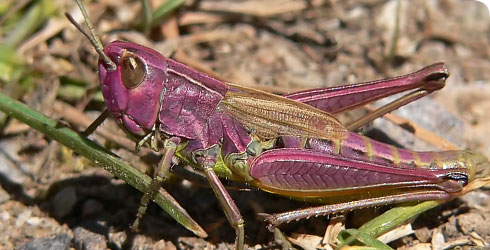Biology
Chorthippus parallelus lays eggs in pods of up to 10, just below the soil surface. Females prefer to lay eggs on bare ground and often use ant-hills where grass is otherwise dense.
The eggs hatch from late April onwards. There are 4 nymphal instars and adults appear from June onwards, sometimes surviving well into November.
Most adults are green, often with brown wings, and sometimes completely brown. Mature males have a yellowish green abdomen, brownish at the tip.
Rarely vivid pink female nymphs are seen, which develop into pinkish-purple adults.
Adults are small and normally have short wings. Most are unable to fly, but large populations may occasionally produce considerable numbers of macropterous, fully-winged adults. These can disperse much further than the flightless form.
Its dimensions are:
- total body length: male: 10–16mm, female: 16–22mm
- forewing length: male: 6–11mm, female 4–8mm,
- forewing length in macropterous form: male: 12–14mm, female: 13–16mm
The adult males produce a short song of 1–3 seconds, beginning quietly and becoming louder; there is no special courtship song though males often chirp more rapidly when females are present.
Look alikes
The long-winged form of Chorthippus parallelus can be confused with its close relative the lesser marsh grasshopper, Chorthippus albomarginatus. Both species may be present in some areas.
Standing out from the crowd
Rarely, vivid pink female nymphs are seen which develop into pinkish-purple adults.
The unusual pink colour variety is also seen in a few other species of Orthoptera, notably the North American round-winged katydid, Amblycorypha rotundifolia, in which the adult retains the astounding colour.
The orchid mantis, Hymenopus coronatus, often has vivid pink nymphs, though the colour is lost in the adult stage.
